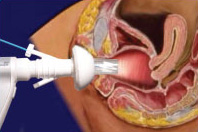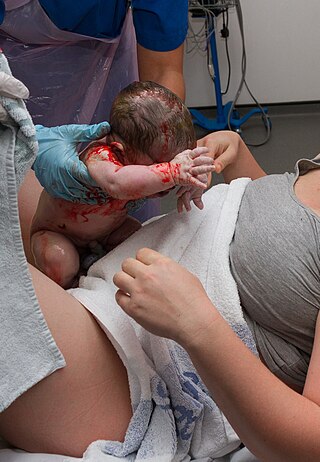
Gynaecology or gynecology is the area of medicine that involves the treatment of women's diseases, especially those of the reproductive organs. It is often paired with the field of obstetrics, forming the combined area of obstetrics and gynaecology (OB-GYN).
An eye care professional is an individual who provides a service related to the eyes or vision. It is any healthcare worker involved in eye care, from one with a small amount of post-secondary training to practitioners with a doctoral level of education.
A medicalintern is a physician in training who has completed medical school and has a medical degree, but does not yet have a license to practice medicine unsupervised. Medical education generally ends with a period of practical training similar to internship, but the way the overall program of academic and practical medical training is structured differs depending upon the country, as does the terminology used.
Adolescent medicine, also known as adolescent and young adult medicine, is a medical subspecialty that focuses on care of patients who are in the adolescent period of development. This period begins at puberty and lasts until growth has stopped, at which time adulthood begins. Typically, patients in this age range will be in the last years of middle school up until college graduation. In developed nations, the psychosocial period of adolescence is extended both by an earlier start, as the onset of puberty begins earlier, and a later end, as patients require more years of education or training before they reach economic independence from their parents.

Maternal–fetal medicine (MFM), also known as perinatology, is a branch of medicine that focuses on managing health concerns of the mother and fetus prior to, during, and shortly after pregnancy.
Medical education in Philippines is principally offered and developed by accredited and government recognized medical schools in the country.
Reproductive endocrinology and infertility (REI) is a surgical subspecialty of obstetrics and gynecology that trains physicians in reproductive medicine addressing hormonal functioning as it pertains to reproduction as well as the issue of infertility. While most REI specialists primarily focus on the treatment of infertility, reproductive endocrinologists are trained to also test and treat hormonal dysfunctions in females and males outside infertility. Reproductive endocrinologists have specialty training (residency) in obstetrics and gynecology (ob-gyn) before they undergo sub-specialty training (fellowship) in REI.
Various topics in medicine relate particularly to the health of lesbian, gay, bisexual, transgender, queer, intersex and asexual (LGBTQIA) individuals as well as other sexual and gender minorities. According to the US National LGBTQIA+ Health Education Center, these areas include sexual and reproductive health, mental health, substance use disorders, HIV/AIDS, HIV-related cancers, intimate partner violence, issues surrounding marriage and family recognition, breast and cervical cancer, inequities in healthcare and access to care. In medicine, various nomenclature, including variants of the acronym LGBTQIA+, are used as an umbrella term to refer to individuals who are non-heterosexual, non-heteroromantic, or non-cis gendered. Specific groups within this community have their own distinct health concerns, however are often grouped together in research and discussions. This is primarily because these sexual and gender minorities groups share the effects of stigmatization based on their gender identity or expression, and/or sexual orientation or affection orientation. Furthermore, there are subpopulations among LGBTQIA+ groups based on factors such as race, ethnicity, socioeconomic status, geographic location, and age, all of which can impact healthcare outcomes.
Urogynecology or urogynaecology is a surgical sub-specialty of urology and gynecology.

The American College of Obstetricians and Gynecologists (ACOG) is a professional association of physicians specializing in obstetrics and gynecology in the United States. Several Latin American countries are also represented within Districts of the organization. It is a 501(c)(3) organization with a membership of more than 60,000 obstetrician-gynecologists and women's health care professionals. It was founded in 1951.
Obstetrical nursing, also called perinatal nursing, is a nursing specialty that works with patients who are attempting to become pregnant, are currently pregnant, or have recently delivered. Obstetrical nurses help provide prenatal care and testing, care of patients experiencing pregnancy complications, care during labor and delivery, and care of patients following delivery. Obstetrical nurses work closely with obstetricians, midwives, and nurse practitioners. They also provide supervision of patient care technicians and surgical technologists.
In 2006, hospice and palliative medicine was officially recognized by the American Board of Medical Specialties, and is co-sponsored by the American Boards of
St. Paul's Hospital Millennium Medical College is Health Sciences teaching institution at St. Paul Hospital, Addis Ababa Ethiopia.
Sandra Ann Carson is an American obstetrician who is the principal innovator of the first artificial human ovary. This innovation was reported in the Journal of Assisted Reproduction and Genetics, and recognized by Time magazine as one of the top 10 medical breakthroughs in 2010.
The United States Veterans Health Administration (VHA) has an LGBTQ+ Program through the Office of Patient Care Services. The “+” sign captures identities beyond LGBTQ, including but not limited to questioning, pansexual, asexual, agender, gender diverse, nonbinary, gender-neutral, and other identities. VHA began collecting data on veteran’s sexual orientation and gender identity in 2022 to inform policy and improve clinical care. There are estimated to be more than one million LGBTQ+ Americans who are military veterans. If LGBTQ+ veterans use VHA at the same rate as non-LGBTQ+ veterans, there could be more than 250,000 LGBTQ+ veterans served by VHA. Using diagnostic codes in medical record data, Blosnich and colleagues found that the prevalence of transgender veterans in VHA (22.9/100,000) is five times higher than reported prevalence of transgender-related diagnoses in the general population (4.3/100,000). Brown and Jones identified 5,135 transgender veterans receiving care in VHA using a broader set of diagnostic codes. Brown also notes that this methodology fails to identify transgender veterans who have not disclosed their gender identity to providers, those who don’t meet criteria for a diagnosis, or veterans who get their transition-related care outside of the VHA.
An obstetric hospitalist is an obstetrician and gynaecologist physician who is either employed by a hospital or a physician practice and whose duties include providing care for laboring patients and managing obstetric emergencies. Some obstetrics hospitalists also have responsibilities including resident and medical student teaching; providing backup support for family practitioners and nurse midwives, assisting private physicians with surgery, assuming care for ob-gyn patients unassigned to a physician and providing vacation coverage for the private practicing physician.
The American Board of Obstetrics and Gynecology is a non-profit organization that provides board certification for practicing obstetricians and gynecologists in the United States and Canada. It was founded in 1927, incorporated in 1930, and is based in Dallas, Texas. It is one of 24 medical boards recognized by the American Board of Medical Specialties. ABOG's mission is to define the standards, certify obstetricians and gynecologists, and facilitate continuous learning to advance knowledge, practice, and professionalism in women's health.

The Society of Family Planning (SFP) is an international non-profit professional organization established in 2005 specializing in "abortion and contraception science" composed of physicians, nurses, sociologists, public health practitioners and trainees in these fields. The majority of member physicians include specialists of obstetrics and gynecology, family medicine, and adolescent medicine.

Duru Shah is a Mumbai-based gynaecologist academic and women activist. She is the Founder President of the PCOS Society, India and a promoter of adolescent girls and women's health and infertility in India. Shah is also the promoter of Metropolis Healthcare Ltd. She is also a Consultant ObGyn.: Breach Candy Hospital, Jaslok Hospital, Mumbai.
Ebony Carter is an obstetrician, reproductive health equity researcher and professor of obstetrics and gynecology at the University of North Carolina School of Medicine. Carter is the Director of the Division of Maternal-Fetal Medicine at University of North Carolina School of Medicine. As a physician-scientist, Carter is known for her research and implementation of community-based interventions to improve health equity among pregnant patients. Carter is the inaugural Associate Editor of Equity for the academic journal Obstetrics and Gynecology, published by the American College of Obstetricians and Gynecologists (ACOG).





